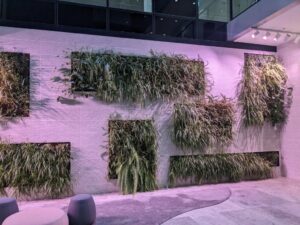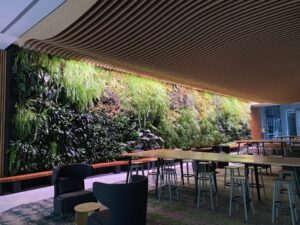
The green advantage
How nature-inspired workplaces are keeping staff loyal
By Michael Casey
Green infrastructure is reshaping schools in Australia and around the world. But its impact need not stop at the school gate. Could similar approaches improve our workplaces, making them healthier, more inviting spaces? And how might this kind of greening help employers attract and retain staff in a post-COVID world?
This is something I have long considered more than just theory. Through my work with schools, I have seen firsthand how increasing green spaces, whether through gardens, shaded outdoor classrooms, or simply more trees in the schoolyard, can transform how students learn, play, connect and behave. It is not just about making a space look nicer, it is about shaping the way young people feel within that environment and around others.
The evidence is growing, and projects like my school garden that featured in the Centre for Urban Greenery and Ecology’s (CUGE) CITYGREEN journal (Volume 18, 2020) initiative only reinforce what so many of us already know: that greenery supports mental wellbeing, encourages focus, and fosters social interaction in ways no artificial space ever could. Watching students regulate themselves better under the shade of a tree or participate more confidently in their learning because the space feels welcoming and calm has left a lasting impression. These experiences have deeply shaped how I view the broader built environment. The wellbeing of children is so evidently linked to their surroundings and the same is true for adults. If green infrastructure is having that kind of transformative impact in schools, what could it do for the places we work?

There is a quiet revolution underway in office spaces, and it is not about standing desks, fully equipped kitchens and hybrid work models. It is rooted in something far more fundamental and far older than our concrete towers and glass walls. It is about bringing nature back into the places we spend our time and recognising that a greener office is not just about aesthetics or sustainability credentials. It is about people. More specifically, it is about how people feel in their workplace, and whether they will choose to stay or quietly start looking elsewhere.
The idea that a green office can make someone more loyal to their employer might once have been brushed off pre-Covid. But we now know, with increasing clarity, that greenery in a workplace does something powerful and that it grounds us. It softens the hard lines of corporate interiors, quiets the overstimulation of screens, artificial light and schedules, and reconnects us, subtly but significantly, to natural rhythms we have evolved alongside for millennia. As work has become more hybrid, fluid, and demanding, our expectations of the workplace have shifted, and employees are no longer willing to spend eight hours a day in sterile, windowless spaces. They want to feel good where they work and the current sterile light, and stale recirculated air all leads to what many in the office space refer to as sick building syndrome. In the eyes of our industry, greenery can alleviate or in some cases fix these issues, often in ways that outperform even the most sophisticated wellness program.
When we talk about green office spaces, we are not just talking about a few token plants in the corner of a lobby. We are talking about biophilic design embedded into the heart and soul of the workspace. That could mean vertical gardens, clusters of indoor trees, light-filled atriums, planter-lined walkways, even views that prioritise the presence of nature rather than the dominance of car parks. These green elements are not just background decoration or the stylised design elements included by interior designers; they are intentional, functional components of a workplace that recognises people as its most valuable asset. And importantly, they signal that an organisation cares about the environment and the wellbeing of its staff, not just its bottom line.
What is emerging from research and real-world experience is the undeniable link between green workplaces and retention. Put simply, people stay where they feel good, and they are more likely to feel a sense of pride in their environment, less likely to call in sick, and more inclined to speak positively about where they work. Staff retention is not just about pay scales and perks anymore. It is about culture, and culture is deeply shaped by place. When that place invites nature in, it invites people to stay.
There is something innately calming about being surrounded by greenery. Stress levels decrease. Focus improves. Air quality is better. Conversations feel less transactional, more human. People walk into green workplaces, and their posture literally shifts. You can see it. In a world that often runs too fast and too hard, a green office gives employees a reason to exhale. And that exhale which can be viewed as a moment of pause is where loyalty starts. It is where the frantic question of ‘Should I leave?’ becomes ‘Actually, I like it here.’
It is important to note that green design is not reserved for the most elite or architecturally ambitious workplaces. While yes, some firms have gone all out with rooftop gardens and indoor forests, many of the benefits can be achieved with far simpler interventions. Even a strategic network of well-maintained indoor plants, smartly placed to soften acoustics and boost visual interest, can reshape the feel of a space. Access to daylight, natural ventilation, and views of outdoor planting all help build a culture of care and connectedness. These elements do not require massive budgets; however, they do require a strategic approach. And that intention, once again, sends a message to staff that they matter.
There is also a generational dimension to this shift. Younger workers entering the workforce today are highly attuned to sustainability and workplace wellness. They are not looking for jobs but for environments where they can thrive. Green office spaces become part of that value proposition as they reinforce a sense of belonging to something bigger than just business as usual. When a workplace reflects environmental values, when it visibly contributes to sustainability goals, it taps into the purpose-driven mindset that many employees now seek. Retention then becomes less about effort and more about alignment and of course we cannot talk about green office space and retention without also considering flexibility. Remote work has made it easier for employees to walk away from office culture entirely, particularly if that culture is uninspiring. Green workplaces give organisations a competitive edge where they make people want to come back in and this is not just because they must, but because it feels good to be there. You cannot underestimate that importance in a post-pandemic world. The companies who understand this are designing for experience, not just efficiency and staff retention. And nature is central to that experience.

From an operational point of view, the benefits go well beyond staff satisfaction. Green offices can contribute to reduced energy use, improved thermal comfort, and lower noise pollution, but perhaps the most underestimated benefit is the way they reframe the relationship between people and place. Offices are now becoming more than just work zones, they become living systems and people tend to want to stay part of something that feels alive, evolving, and human.
In Australia, we are seeing this conversation gain real traction, not just in capital cities but increasingly in regional hubs as well. The recognition that we need to design places for people, not just profit, is catching on, with forward-thinking developers, landlords, and tenants asking smarter questions about how to create a space that supports wellbeing and how our buildings contribute to biodiversity. How a workplace becomes an asset to community and not just a structural commercial or industrial space is a huge change in mindset and design strategies. It is something we see more of now as commercial and residential sectors start to seamlessly blend into suburbs. Take the recent construction of The Bruce commercial office space in the north of Melbourne that provides green roofs and facade planting to ensure biodiversity thrives in this built-up suburb, along with adequate greenery for the staff that use this workspace.
For those in leadership, human resources, or facilities management roles, the message is clear. Retention starts long before the exit interview. It starts with the environment you create for your team ensuring it’s an environment that is nourishing, inspiring, and is human. If your staff feel boxed in by walls and fluorescent lights, they will eventually leave, even if everything else looks good on paper. But if your workplace gives them sunlight, fresh air, and something green to look at, they are far more likely to stay, grow, and contribute long-term.
In the end, green office spaces are not a trend but a necessary recalibration. A recognition that we have designed too many places without thinking about the people in them, and now, as we rebuild our work lives and reimagine the future of the office, nature is quietly, insistently, showing us a better way. A greener way. One that helps keep good people around for all the right reasons.
Michael Casey
Director, Evergreen Infrastructure
Company Director, Australasian Green Infrastructure Network
Technical Panel, AIPH World Green Cities Awards
World Ambassador for World Green Roofs Day
E: michael@evergreeninfrastructure.com.au
